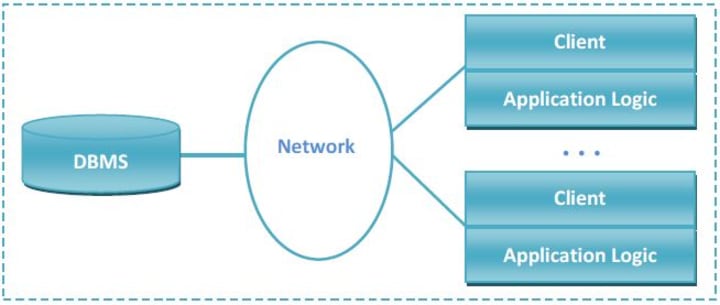
4.1 Centralized Database Systems
The centralized database systems run on a single computer system. It can either be a single user database system which runs on a personal computer, or else a database system which runs on a high performance computer such as a mainframe, which will be accessed through dumb terminals. The dumb terminals will only user for data input and output.
Before proceeding it is necessary to get an idea about different functional components of data-intensive applications. There are three components to consider;
(1) Data Management/DBMS: Concerned with the data and its manipulations
(2) Application Logic: Concerned with the rules applied when presenting data
(3) Presentation/ Client: Concerned with the presentation of data to client
However the main feature of centralized database systems is that all typical functional components are running in a single tier. The Figure 4.1 shows the basic architecture of a single-tier database system.

Single-tire or centralized database systems were not adequate specially when there are higher number or users expecting sophisticated facilities via the database systems such as Graphical User Interfaces. This requires a lot of computational power from the machine on which the system is running and therefore unable to cater for thousands of users.
4.2 Client/Server Architecture
Client/server architecture has been introduced as a resolution to the issues encountered with centralized database systems. We will discuss about two-tier architecture and Three-tier architecture in this section.
4.2.1 Two-tier Architecture
The initial introduction was the two-tier architecture which consists of a client computer and a server computer. These two will interact with each other via a well-defined set of rules. That set of rules is called a protocol.The client/server architecture can be discussed under two norms based on the functionality of the client and the server. Main focus for the division is the functionality of the client, and accordingly the server functionality would vary.
Thin client:
The processing and the availability of the Application logic are at the server side. The client only accesses the data services provided by the server. The client just implements the user interface through which the server is accessed. As there is no processing at the client side, the client is called a Thin-client (refer Figure 4.2). This architecture is considered to be the typical client/server architecture.

Thin client two-tier architecture separates the presentation issues from the rest of the application.
Thick client:
Thick clients implement the user interface and the business/application logic. The client can either fully implement the application logic, or else a part of the logic. How ever in the latter case the other part of the logic is implemented at the server level. The Figure 4.3 illustrates the architecture of a client/server system with a thick client.

However, the thick clients have disadvantages in different perspectives. As the business logic is implemented at the client, the logic cannot be updated centrally, and therefore may lead to inconsistencies, and difficulties in maintenance. Also, the system needs to be assured about the trustworthiness of the client from whom the request for data is coming. Scalability of the system is also an issue, as the there would be a large volume of query results passed between client and server. This will limit the number of clients handled by the server.
4.2.2 Three-tier Architecture
Three-tier architecture has been presented by further separating the functional components of database systems. That is, the three major components; presentation, application logic and DBMS are presented in three different tiers. In other words, in addition to the separation of presentation, the application logic and the data management are also separated from each other. Following are the tiers considered in this architecture.
Presentation tier: Contains the user interfaces through which the input is done and the results are seen. Web-based interfaces are becoming more popular in this context.
Middle tier: Implementation of application logic and there execution happens here.
Data Management Tier: The DBMS is the main consideration in this tier on which the data-intensive program runs.
These tiers can be distributed across different platforms and different physical sites, and based on that the architectural overview can slightly vary. How ever the Figure 4.4 will illustrate the standard three-tier architecture on which the other variations are formed.

The Three-tier architecture has very prominent advantages compared to two-tier architecture. Some of them are;
• Possibility to use different platforms and software components
• Clients needs to handle only the presentation layer and therefore needs less computing power
• Data can be accessed from different sources
• Scalability to many clients as clients directly deals with the middle-tier which
shares the database connections across clients (refer Figure 4:5 for overall
structure)
• The business logic can be maintained easily






Comments
There are no comments for this story
Be the first to respond and start the conversation.